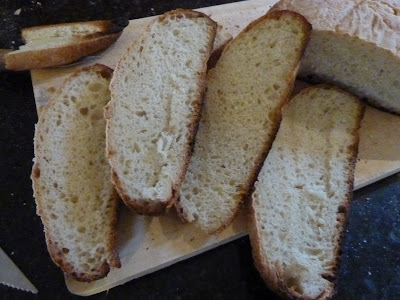About a month ago, I finally got a digital scale, a couple of serious baking books (Crust and Crumb by Peter Reinhart and Local Breads by Daniel Leader) and a 50 pound sack of King Arthur Special Bread Flour. Good bread takes time and coordination (more of the latter), but it can definitely be worth the commitment.
Here's the sack, with ~35 pounds left.

My first bread was the second of Reinhart's two versions of French bread, made using a pre-ferment reserved from the previous batch of dough called pate fermenté. Of course, if there is no previous batch, you have to make it fresh. Because it is just the leftover dough, the recipe is identical, but the pre-ferment adds depth and flavor to the bread.
Here's the dough after rising.
You form the baguettes by patting the dough gently into a rectangle which then gets folded like an envelope and pinched closed. After a couple folds, with rests in between to relax the gluten, you roll the baguettes out. You then cover the formed loaves and let them proof in the fridge overnight to let the grains ferment which deepens the flavor of the final bread. In Reinhart's words, "the long, slow rise of overnight retarding produces a more spectacular loaf, richer in color with a dramatic blistered crust." The next picture is after proofing. The baguettes grew a lot - I really didn't have room for them but I think they should have been longer.Here's the sack, with ~35 pounds left.

My first bread was the second of Reinhart's two versions of French bread, made using a pre-ferment reserved from the previous batch of dough called pate fermenté. Of course, if there is no previous batch, you have to make it fresh. Because it is just the leftover dough, the recipe is identical, but the pre-ferment adds depth and flavor to the bread.
Here's the dough after rising.
I also wanted to make one boule. There was some crazy yeast action during the final rise.
The baguettes tasted good and the crumb was pretty open, but I think they may have been slightly overproofed because they didn't really rise in the oven. Also, the scoring is poorly done because I didn't know at the time that wetting the blade would prevent it from dragging in the dough. My struggle to make those slashes probably deflated the dough somewhat. (I've been using a double edged safety razor threaded on a twig as a makeshift lamé, pictured in the next post.)
Cross section - the crumb turned out better than the crust. No shattering, blistered crust, but great flavor and texture.The boule didn't come out of that metal bowl without a fight and deflated a lot before going into the oven. Luckily it recovered enough to be a tasty loaf, if not the prettiest.
This bread had a lot of flavor and a kind of sweetness to it. I've had better but not too shabby for a start.
Round two was a second attempt at the same french bread recipe using dough reserved from the first batch for the pre-ferment along with a San Francisco sourdough made with my starter.
The white bowl at left holds the firm starter the recipe called for. The other bowl is full of the french bread dough.
The starter overflowed its bowl.
Both the sourdough and the french bread proof overnight in the fridge, so it was a challenge finding space for all of these guys. The french bread made three baguettes and 4 rolls. The sourdough made two boules, two mini-boules, 8 rolls and a mini baguette.
Here they are, hot out of the oven. The baguettes may have actually been worse than the first time. They really didn't rise at all in the oven, possibly because the scoring was bad again but also because they didn't start out directly on the baking stone. The sour dough was really good, but
The sourdough was really good, but that oven spring is elusive.
The third (and so far, last) bread that I've baked from Reinhart's book was a whole grain bread leavened with sourdough starter. I used freshly rolled oats, rye flakes, and cracked wheat berries and polenta for the whole grains. In addition to bread flour, there was also honey, brown sugar and milk (substituted for buttermilk without ill effect, though I would like to try again with the right stuff).
I made one pan loaf, a boule, and ten rolls. Some rolls were topped with poppy seeds, some with sesame and some with a mix, plus a few plain. Very good, but maybe a little underdone.













No comments:
Post a Comment